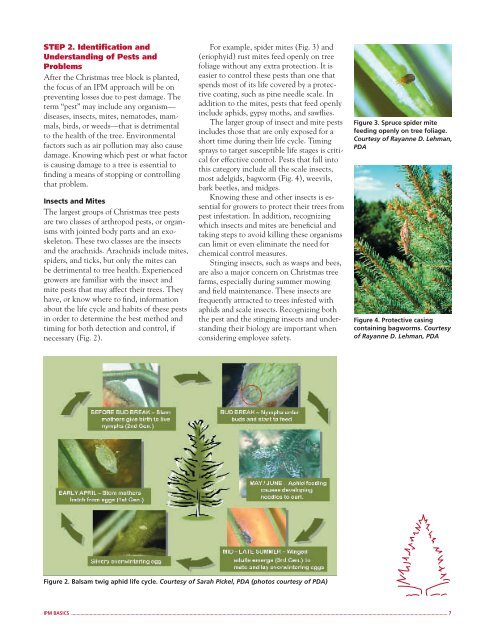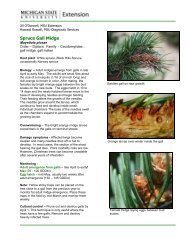Integrated Pest Management for Christmas Tree Production: A ...
Integrated Pest Management for Christmas Tree Production: A ...
Integrated Pest Management for Christmas Tree Production: A ...
Create successful ePaper yourself
Turn your PDF publications into a flip-book with our unique Google optimized e-Paper software.
STEP 2. Identifi cation and<br />
Understanding of <strong>Pest</strong>s and<br />
Problems<br />
After the <strong>Christmas</strong> tree block is planted,<br />
the focus of an IPM approach will be on<br />
preventing losses due to pest damage. The<br />
term “pest” may include any organism—<br />
diseases, insects, mites, nematodes, mammals,<br />
birds, or weeds—that is detrimental<br />
to the health of the tree. Environmental<br />
factors such as air pollution may also cause<br />
damage. Knowing which pest or what factor<br />
is causing damage to a tree is essential to<br />
fi nding a means of stopping or controlling<br />
that problem.<br />
Insects and Mites<br />
The largest groups of <strong>Christmas</strong> tree pests<br />
are two classes of arthropod pests, or organisms<br />
with jointed body parts and an exoskeleton.<br />
These two classes are the insects<br />
and the arachnids. Arachnids include mites,<br />
spiders, and ticks, but only the mites can<br />
be detrimental to tree health. Experienced<br />
growers are familiar with the insect and<br />
mite pests that may affect their trees. They<br />
have, or know where to fi nd, in<strong>for</strong>mation<br />
about the life cycle and habits of these pests<br />
in order to determine the best method and<br />
timing <strong>for</strong> both detection and control, if<br />
necessary (Fig. 2).<br />
For example, spider mites (Fig. 3) and<br />
(eriophyid) rust mites feed openly on tree<br />
foliage without any extra protection. It is<br />
easier to control these pests than one that<br />
spends most of its life covered by a protective<br />
coating, such as pine needle scale. In<br />
addition to the mites, pests that feed openly<br />
include aphids, gypsy moths, and sawfl ies.<br />
The larger group of insect and mite pests<br />
includes those that are only exposed <strong>for</strong> a<br />
short time during their life cycle. Timing<br />
sprays to target susceptible life stages is critical<br />
<strong>for</strong> effective control. <strong>Pest</strong>s that fall into<br />
this category include all the scale insects,<br />
most adelgids, bagworm (Fig. 4), weevils,<br />
bark beetles, and midges.<br />
Knowing these and other insects is essential<br />
<strong>for</strong> growers to protect their trees from<br />
pest infestation. In addition, recognizing<br />
which insects and mites are benefi cial and<br />
taking steps to avoid killing these organisms<br />
can limit or even eliminate the need <strong>for</strong><br />
chemical control measures.<br />
Stinging insects, such as wasps and bees,<br />
are also a major concern on <strong>Christmas</strong> tree<br />
farms, especially during summer mowing<br />
and fi eld maintenance. These insects are<br />
frequently attracted to trees infested with<br />
aphids and scale insects. Recognizing both<br />
the pest and the stinging insects and understanding<br />
their biology are important when<br />
considering employee safety.<br />
Figure 2. Balsam twig aphid life cycle. Courtesy of Sarah Pickel, PDA (photos courtesy of PDA)<br />
Figure 3. Spruce spider mite<br />
feeding openly on tree foliage.<br />
Courtesy of Rayanne D. Lehman,<br />
PDA<br />
Figure 4. Protective casing<br />
containing bagworms. Courtesy<br />
of Rayanne D. Lehman, PDA<br />
IPM BASICS .............................................................................................................................................................................................................................................................................................. 7





